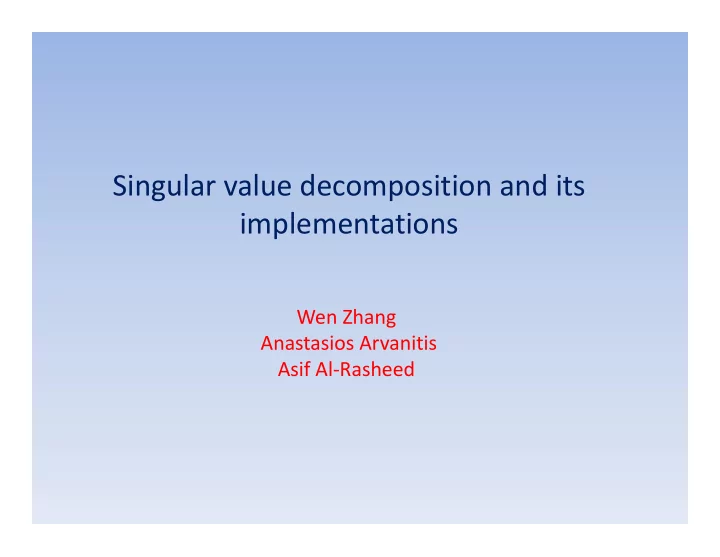

Singular value decomposition and its implementations W Wen Zhang Zh Anastasios Arvanitis Asif Al ‐ Rasheed
Outlines Outlines • Implementation of indirect method ‐ Matlab code ‐ Testing results • Implementation of direct method ‐ Matlab code Matlab code ‐ Testing results ‐ Combined method Combined method • Comparisons of different method
Implementation of Indirect method function [u,d,v]=SVDecom(A) if (m<n||m==n) [m,n]=size(A); sinflag=0; [v,d]=eig(A'*A); if (m>n) v=GSO(v); v=fliplr(v); [u,d]=eig(A*A’); u=GSO(u); u=fliplr(u); d1=zeros(m,n); d1(1:n,n+1:m)=zeros(n,m ‐ n); dd=fliplr(diag(d.^(.5))'); dd=fliplr(diag(d.^(.5))’)’; d1(1:m,1:m)=diag(dd(1:m)); d1(1:n,1:n)=diag(dd(1:n)); d=d1; d1(1:n 1:n)=diag(dd(1:n)); d=d1; d=d1; d=d1; for i=1:n for i=1:m if (d(i,i)~=0) if(d(i,i)~=0) v(:,i)=A’*u(:,i)/d(i,i); u(:,i)=A*v(:,i)/d(i,i); T T else l else l T T AA approach A A approach sinflag=1; v(:,i)=ones(n,1); sinflag=1; end u(:,i)=ones(m,1); end end v=GSO(v); end if (sinflag==1) u=GSO(u); v=GSO(v); if (sinflag==1) end d u=GSO(u); GSO( ) d=d’; end end end
The process of GSO The process of GSO for j=2:m function Q=GSO(A) Double Q(:,j)=Q1(:,j); [n,m]=size(A); Q1(:,1)=A(:,1); [n,m] size(A); Q1(:,1) A(:,1); Orthogonalize Orthogonalize for i=1:j ‐ 1 for j=2:m x=Q(:,i); a=Q1(:,j); qnorm=x'*x; Q1(:,j)=A(:,j); if(qnorm~=0) for i=1:j ‐ 1 j Q(:,j)=Q(:,j) ‐ (a *x)/qnorm*x; Q(: j) Q(: j) (a'*x)/qnorm*x; x=Q1(:,i); a=A(:,j); qnorm=x'*x; end if (qnorm~=0) end Q1(:,j)=Q1(:,j) ‐ (a'*x)/qnorm*x; end end for i=1:m end qnorm=Q(:,i);x=(qnorm'*qnorm); end if(x~=0) Normalize Normalize Q( 1) Q1( 1) Q(:,1)=Q1(:,1); Q(:,i)=Q(:,i)/(x^(0.5)); / end end
Some test results of Indirect method Some test results of Indirect method >> A=rand(150,40); >> norm(v'*v ‐ eye(40),1) >> [u,d,v]=SVDecom (A); ans = 1.8991e ‐ 015 >> norm(u*d*v' A 1) >> norm(u*d*v ‐ A,1) >> norm(v*v' ‐ eye(40),1) ans = 4.3643e ‐ 013 ans = 2.4568e ‐ 015 >> norm(u*d*v' ‐ A,inf) ( , ) ans = 4.6653e ‐ 013 >> [u1,d1,v1]=svd(A); >> norm(u*u' ‐ eye(150),1) >> norm(d1 ‐ d,inf) (d1 d i f) ans = 6.6027e ‐ 015 >> norm(u'*u ‐ eye(150),1) ans = 1.1546e ‐ 014 ans = 5 7560e 015 ans = 5.7560e ‐ 015
Implementation of Direct method function [u,b,v]=BiDiag(A) [m,n]=size(A); n1=min(m,n); First, transform to bidiagonal matrix: u1=Householder(A(:,1));b=u1*A; A1=b'; a=A1(2:n 1); v2=Householder(a); a=A1(2:n,1); v2=Householder(a); v1(2:n,2:n)=v2’;v1(1,1)=1; b=b*v1; T A UBV u=u1;v=v1; for i=2:n1 ‐ 2 a=b(i:m,i); clear u1; u1(1:i ‐ 1,1:i ‐ 1)=eye(i ‐ 1); u1(i:m,i:m)=Householder(a); Get a sequence of u1 and v1 by Get a sequence of u1 and v1 by b=u1*b; A1=b'; a1=A1(i+1:n,i); * ' ( ) Householder & identity matrices v2=Householder(a1); clear v1; v1(1:i,1:i)=eye(i); v1(i+1:n i+1:n)=v2'; v1(i+1:n,i+1:n)=v2 ; b=b v1; u=u u1; b=b*v1; u=u*u1; v=v*v1; end a=b(n1 ‐ 1:m,n1 ‐ 1);clear u1; u1(1:n1 ‐ 2,1:n1 ‐ 2)=eye(n1 ‐ 2); u1(n1 ‐ 1:m,n1 ‐ 1:m)=Householder(a); b=u1*b; u=u*u1;
b b 1 2 O b b 3 4 B b b 2 n 3 2 n 2 O O O O Using Shuffle U i Sh ffl ( ( m n ) ) n b 2 n 1 matrix P: O T T O B B B P P P P 1 B O 0 b 0 O 1 b b 0 0 b b 1 2 0 b 0 2 B 1 0 b 2 n 1 O b 0 2 n 1
About the Shuffle matrix About the Shuffle matrix The Shuffle matrix P is defined by: The Shuffle matrix P is defined by: P e e e e e e [ ] 1 n 1 2 n 2 n 2 n function p=GenerateShuff(m) >> GenerateShuff(3) for i=1:2:2*m ‐ 1 ans = p(:,i)=geneVector(2*m,(i+1)/2); end d 1 0 0 0 0 0 for i=2:2:2*m 0 0 1 0 0 0 p(:,i)=geneVector(2*m,i/2+m); 0 0 0 0 1 0 end 0 1 0 0 0 0 0 0 0 1 0 0 function p=geneVector(m,n) 0 0 0 0 0 1 p(m)=0;p=p'; p(n) 1; p(n)=1;
Get the SVD of bidiagonal matrix Get the SVD of bidiagonal matrix function [u,d,v]=SVDUpBidiag(B) 0 b 0 1 [m,n]=size(B); Get eigen pairs of b b 0 0 b b O O B1=B(1:n 1:n); B1=B(1:n,1:n); 1 1 2 2 C(1:n,n+1:n+n)=B1'; 0 b 0 2 C(n+1:2*n,1:n)=B1; p=GenerateShuff(n); 0 0 b b c1=p'*C*p; 2 n 1 [x,d]=eig(c1); O b 0 2 n 1 x1=fliplr(x); d1=fliplr(flipud(d)); d1=fliplr(flipud(d)); Via the relation: Via the relation: d=d1(1:n,1:n); 1 ( x1=x1(:,1:n); T h v , u , v , u , , v , u ) i i 1 i 1 i 2 i 2 in in x1=x1*2^(.5); 2 f for i=1:n v(i,:)=x1(2*i ‐ 1,:); u(i,:)=x1(2*i,:); to get SVD of B end end d(n+1:m,1:n)=zeros(m ‐ n,n); u(n+1:m,n+1:m)=eye(m ‐ n);
C Combined method bi d h d • Transform the original matrix to the bidiagonal matrix, then to get SVD of bidiagonal: ‐ Use built ‐ in function ‐ Use indirect method U i di t th d ‐ Use Francis algorithm (cont’)
Log-log plot of timing for different method 2 10 Jacob Indirect 1 10 onds) Direct Comb Indirect Comb Indirect SVD (seco Built-in 0 Comb Built-in 10 e cost of S -1 10 The time -2 10 -3 10 1 2 3 10 10 10 10 10 10 Dimension of square matrix
Log-log plot of accuracy against dimension -9 10 Built in B ilt i -10 Direct 10 rithms Jacob Indirect erent algor -11 Comb built in 10 Comb Squaring acy of diffe -12 10 The accura -13 13 10 -14 T 10 10 -15 10 10 1 2 3 10 10 10 Dimension of square matrix
Th k Thank you! !
Recommend
More recommend